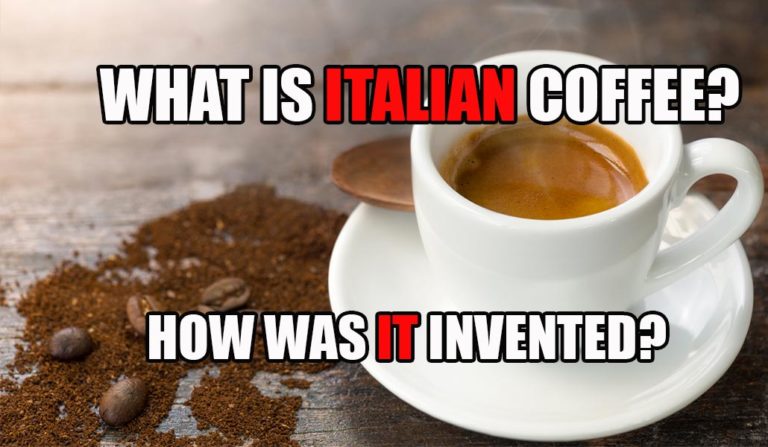Since the 1500s the Italians have been hard at work developing coffee beverages including the vocabulary associated with ordering coffee and equipment. So, what is Italian Coffee? In this article, we will discuss Italian coffee and better yet, how to make it without spending a small fortune.
What Is Italian Coffee?
Italian coffee is an espresso made in a way to cool it down enough so you can drink it right away. Italian coffee essentially resembles a fast way to get a cup of coffee in a friendly environment.
1. Cappuccino – Italians are well known for eating and drinking at certain times of the day, this is because of how it affects the digestion system. One of the most popular drinks in Italy, considered a meal itself with the foam and milk, often it won’t be ordered anytime after 11 am.
2. Machiato – Italians consider it perfectly acceptable to have any time of the day, very similar to the Cappuccino. It’s an espresso mixed with hot milk served in the same cup as an espresso comes in.
3. Caffe Latte – Simply asking for a Latte would serve you a tall glass of milk, commonly ordered before 11 am just like a Cappuccino. It’s 1/3 espresso. 2/3 heated mil, and a little frothy foam on top.
4. Caffè al Ginseng – This ginseng extract prepared with an espresso is consumed either for lunch or dinner. A most similar comparison is US chi tea latte. Italians say it helps with digestion and increased energy levels with no need for added sweeteners.
5. Caffè d’Orzo – Italians drink this style late at night or before bed, it is barley coffee and is 100% naturally caffeine free. Other options are by ordering it “con scorza di d’arancia” which means a slice of orange for added citrus flavor.
6. Shakerato – Italians drink this during summer months on hot and humid days, comparable to Starbucks iced coffee. Basically, an espresso poured over ice and shaken to a froth. Often a refreshing morning drink
7. Marocchino – This coffee drink is slightly milkier compared to a Macchiato, depending on which region in Italy. The standard way is cocoa and espresso, Northern Italy mixes thick hot chocolate with espresso.
8. Caffe – Italians invented the espresso machine, makes sense why Cafe means “Coffee”, it is served throughout the day in a tiny cup. A standard Caffe is a shot of espresso. Looking to add anything extra, try cognac, grappa, or irish cream.
Brief History Of Italian Coffee

In 1683 the Turks retreated ending the second siege of Vienna leaving behind grain, livestock, and around 500 bags of coffee. No idea of what this mysterious content was they began feeding it to camels and dumping extras into the Danube.
Once this news reached a man who lived with the Turks named Kolschitzky he requested the sacks as payment for his effort in services during the siege. Teaching the Viennese how to prep and enjoy the beverage first going home to home, and later opening a large tent to the public. This prime Viennese coffee house set the standards to come across the rest of Europe.
Italians have plenty of history with coffee, one of the first ports in Europe to import coffee was located in Venice Italy during the early 17th century. As Italians did not invent coffee they did pioneer the way we drink coffee nowadays. Ethiopians were among the first who discovered coffee beans itself, trading with the Arabs who saw the potential and sold them to North Africa. From there, the beans gained popularity in India and European markets getting the name “the wine of Arabia”.
Coffee didn’t originate from Italy but through the highlands of Ethiopia thousands of years prior. Prior to arriving in Europe coffee was already a well established cult like following in the middle east. Very nearly getting banned by the Islamic law. The first coffeehouse opened in Istanbul which the beverage followed the spread to parts of Africa and Eastern Europe (Venice, Italy). At that time Eastern Europe relied heavily on Muslim East for trade. Coffee was not a refreshment drink at this point but as a luxury, once the beans spread to parts of Asia and South America it thrived and became accessible to the general public.
Best Way To Make Italian Coffee?
Your easiest way to make Italian coffee is by using a Moka Pot. These pots make a higher concentrated cup of coffee similar to the Italian espresso.
There are three main parts to a Moka Pot: the bottom which is where you fill with water, the holder where you place the coffee grinds, and the top which fills with coffee after the Moka Pot is heated.
Our top 2 Italian coffee maker electric or stovetop:
1 – BonVIVO Intenca Stovetop Espresso Maker
We have been using this espresso maker for over a year now and love the BonVIVO Intenca. It makes a nice rich pot of espresso and is made extremely well with a great design.


Check Out Other Articles On CoffeeBrat.co
How To Make Coffee While Camping?
Proper Way To Roast Coffee Beans – What Can You Do?
What Espresso Machine Does Starbucks Use?
Southeast Asia Coffee Culture – What Does It Mean?
11 Best Coffee Thermoses – How To Choose The Best One?
Once coffee beans were established in Eastern Europe the very first coffee house was opened in Venice, Italy during the early 17th century.
Venetian merchants who became familiar with the drink in Instanbul brought it back with them to Venice. The beverage was sold on the streets by vendors.
Due to religious beliefs Christianity saw it as an Islamic threat and for many years fighting to banish the beverage, popularity continued to gain attraction, and Pope Clement VIII sampled the heated drink with its unique taste and aroma. Once the heated drink was deemed a Christian beverage, the first Italian coffee house was built in Venice, Italy in 1683. This quickly became an atmosphere for good food, conversation, and social stature.
What Coffee Inventions Did Italians Create?

One of the most famous inventions was the Espresso machine by Luigi Bezzera in 1903, This invention revolutionized the coffee industry. His invention was to speed up the coffee making process by forcing water and steam under high pressure to brew coffee at a faster pace.





